Exactly how to Inspect If Your Home Has a Covert Leak
Exactly how to Inspect If Your Home Has a Covert Leak
Blog Article
What're your thoughts and feelings on Top leak detection hacks?

Early discovery of dripping water lines can reduce a potential calamity. Some small water leaks might not be noticeable.
1. Analyze the Water Meter
Every house has a water meter. Examining it is a proven way that assists you discover leakages. For beginners, turn off all the water resources. Guarantee no one will certainly flush, use the tap, shower, run the washing equipment or dishwashing machine. From there, go to the meter as well as watch if it will certainly alter. Since no person is using it, there should be no motions. That shows a fast-moving leak if it relocates. Also, if you detect no changes, wait an hour or more and examine back again. This means you might have a slow leak that might also be underground.
2. Check Water Usage
If you detect abrupt modifications, in spite of your consumption being the same, it suggests that you have leakages in your plumbing system. An abrupt spike in your expense indicates a fast-moving leakage.
A steady increase every month, also with the exact same behaviors, reveals you have a slow-moving leak that's additionally gradually rising. Call a plumber to completely check your residential property, especially if you feel a warm area on your floor with piping below.
3. Do a Food Coloring Test
When it comes to water consumption, 30% comes from toilets. If the shade somehow infiltrates your bowl throughout that time without flushing, there's a leakage between the tank and also dish.
4. Asses Outside Lines
Do not forget to inspect your outdoor water lines as well. Should water leak out of the link, you have a loose rubber gasket. One little leak can lose loads of water and also spike your water expense.
5. Evaluate the scenario and check
Homeowners must make it a behavior to check under the sink counters as well as also inside cabinets for any type of bad odor or mold and mildew growth. These two warnings suggest a leakage so punctual attention is needed. Doing regular inspections, even bi-annually, can save you from a significant trouble.
Much more significantly, if you recognize your residence is already old, keep a watchful eye on your heaters, hose pipes, pipelines and so on. Check for discolorations and compromising as most pipes as well as home appliances have a life span. They will certainly additionally normally deteriorate due to tear as well as use. Do not wait for it to escalate if you presume leaking water lines in your plumbing system. Call an expert plumber immediately so you do not end up with a terrible mess in your house.
Early detection of leaking water lines can alleviate a possible calamity. Some little water leaks might not be noticeable. Examining it is a surefire means that helps you discover leakages. One tiny leakage can waste tons of water and increase your water expense.
If you presume leaking water lines in your plumbing system, do not wait for it to rise.
WARNING SIGNS OF WATER LEAKAGE BEHIND THE WALL
PERSISTENT MUSTY ODORS
As water slowly drips from a leaky pipe inside the wall, flooring and sheetrock stay damp and develop an odor similar to wet cardboard. It generates a musty smell that can help you find hidden leaks.
MOLD IN UNUSUAL AREAS
Mold usually grows in wet areas like kitchens, baths and laundry rooms. If you spot the stuff on walls or baseboards in other rooms of the house, it’s a good indicator of undetected water leaks.
STAINS THAT GROW
When mold thrives around a leaky pipe, it sometimes takes hold on the inside surface of the affected wall. A growing stain on otherwise clean sheetrock is often your sign of a hidden plumbing problem.
PEELING OR BUBBLING WALLPAPER / PAINT
This clue is easy to miss in rooms that don’t get much use. When you see wallpaper separating along seams or paint bubbling or flaking off the wall, blame sheetrock that stays wet because of an undetected leak.
BUCKLED CEILINGS AND STAINED FLOORS
If ceilings or floors in bathrooms, kitchens or laundry areas develop structural problems, don’t rule out constant damp inside the walls. Wet sheetrock can affect adjacent framing, flooring and ceilings.
https://www.servicemasterbyzaba.com/blog/how-to-detect-water-leakage-in-walls/

We were guided to that write-up on Detecting hidden plumbing leaks from a good friend on a different web property. Don't hesitate to take the opportunity to promote this post if you enjoyed it. I treasure reading our article about Locating water leaks.
Report this page